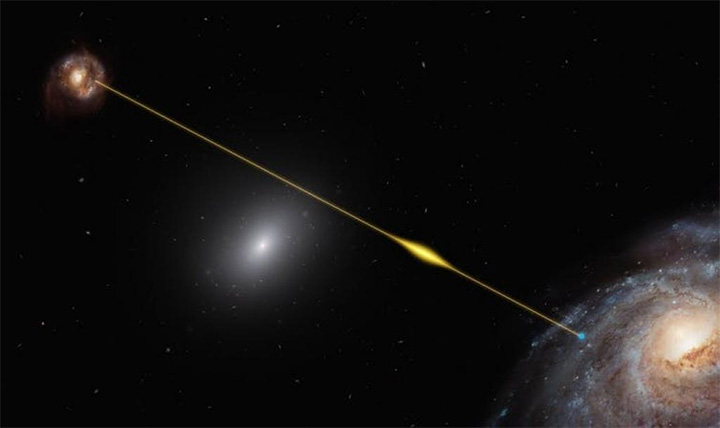Science & Technology
Fast Radio Bursts
- 11 Jun 2021
- 5 min read
Why in News
Recently, researchers from the Pune-based Tata Institute for Fundamental Research (TIFR) and the National Centre for Radio Astrophysics (NCRA), have assembled the largest collection of Fast Radio Bursts (FRBs) catalogue.
- The data is from Canadian Hydrogen Intensity Mapping Experiment (CHIME).
- In 2020, the National Aeronautics and Space Administration (NASA) spotted FRB for the first time in the Milky Way.
Key Points
- Fast Radio Bursts:
- FRB are bright bursts of radio waves (radio waves can be produced by astronomical objects with changing magnetic fields) whose durations lie in the millisecond-scale, because of which it is difficult to detect them and determine their position in the sky.
- It was first discovered in 2007.
 A defining property of these bursts is their dispersion (scattering or separation), the bursts produce a spectrum of radio waves, and as the waves travel through matter, they spread out or disperse with bursts at higher radio frequencies arriving at telescopes earlier than those at lower frequencies.
A defining property of these bursts is their dispersion (scattering or separation), the bursts produce a spectrum of radio waves, and as the waves travel through matter, they spread out or disperse with bursts at higher radio frequencies arriving at telescopes earlier than those at lower frequencies.
- Dispersion can result in signal degradation in many applications, especially over large distances.
- This dispersion allows researchers to learn about two important things:
- They can measure this dispersion to learn about the stuff that radio bursts pass through as they travel toward Earth
- They can indirectly determine how far apart things are.
- FRB are bright bursts of radio waves (radio waves can be produced by astronomical objects with changing magnetic fields) whose durations lie in the millisecond-scale, because of which it is difficult to detect them and determine their position in the sky.
- FRBs Catalogue & Findings:
- The new catalogue significantly expands the current library of known FRBs, and is already yielding clues as to their properties.
- For instance, the newly discovered bursts appear to fall in two distinct classes: those that repeat, and those that don’t.
- The repeaters looked different, with each burst lasting slightly longer and emitting more focused radio frequencies than bursts from single, non-repeating FRBs.
- These differences strongly suggest that emission from repeaters and non-repeaters is generated either by different physical mechanisms or in different astrophysical environments
- The bursts were evenly distributed in space, seeming to arise from any and all parts of the sky.
- Bright FRBs occur at a rate of about 800 per day across the entire sky - the most precise estimate of FRBs overall rate to date.
- Origin of FRBs:
- FRBs have been spotted in various and distant parts of the universe, as well as in our own galaxy. Their origins are unknown and their appearance is highly unpredictable.
- The CHIME project has nearly quadrupled the number of fast radio bursts discovered to date.
- The telescope has detected 535 new FRBs in its first year of operation itself, between 2018 and 2019.
- With more observations, astronomers hope soon to find the origins of the FRBs.
- Chime:
- It is a novel radio telescope that has no moving parts. Originally conceived to map the most abundant element in the universe - hydrogen - over a good fraction of the observable universe, this unusual telescope is optimized to have a high mapping speed.
- It is located at the Dominion Radio Astrophysical Observatory, operated by the National Research Council of Canada in British Columbia, Canada.
- The telescope receives radio signals each day from half of the sky as the Earth rotates.
- Significance of Studying FRBs:
- The unique properties of fast radio bursts and their host galaxies combined with recent technological advancements have given researchers hope that these phenomena can be used to answer some long-standing questions about the universe.
- It can be used to understand the three–dimensional structure of matter in the universe and to learn about poorly understood early moments in the evolution of the universe.






